-
Posts
1,262 -
Joined
-
Last visited
Content Type
Profiles
Forums
Articles
Gallery
Downloads
Events
Posts posted by basher
-
-
I use Airvane 2100 (e201) which was a match for the vintage oil spec on the side of my 300 . Ill go out and get that spec for you as well when im next in the forge.
-
I would agree with Alan . It looks to me like you have a clean hammer.
There is no point fiddling if it ain't broke....
I cleaned up the bore of mine with 200 grit sand paper to remove lose rust and then washed the rust dust away with thin oil and cleaned the surfaces with rags . Did the ram and the front bore and then took the back cylinder to dead bottom and did same on that giving it a good wash through with thin oil.
You can also walk the drive wheel around (literaly standing on top of it) to get some oil pumped to all the bearings before you start it up properly.
I replaced all of the valve springs on mine.
If you manage to free up the bypass valve without damaging it you are doing a better job than me. The valve is very usefull for giving you low powered blows as you can run the machine at partial power ( partial vaccumm) great for punching flattening and the like.
Make sure that you measure the dead bottom depth of the ram as it sits Down upon the wedge . I gave mine a coupe of inches safty margined when working out the anvil and hammer mounting heights. I also put a safty line on the ram with slitting disk at 1" above dead bottom as there was no mark on the ram to indicate this. Some hammers do have a mark.
Good luck with the instilation, these are great hammers . Your 200 is certainly more modern than mine as my one has manual oiling.
I would really advise exhausting the air out of your building as is is so unbelievably noisy if you don't ( hard to think kind of noise). -
I would have a look at Ian wallace ltd they are a craft insurance and will cover makers and demonstrators but not installation . so fine if you make but not if you install. they are by far the cheapest.
easy to find on the net.
-
Alan ,
can I buy you a beer instead some time?
Cheers Owen
-
So are people doing no-flux forge welds with no sparking of the metal at all?
yes in gas at temps of 1250 and up with a reducing flame IN CARBON STEEL.
not the same a the standard "British" method at all.
-
hmmn ,
kind of depends if you are looking for a project or "need" a 200 hammer or "want" a 200 hammer.....
I would think 1500 is a little steep, mainly because of the potential risk of there being something wrong, worn out bores or broken valve body pretty much making it a non starter (financially speaking), If you have the will or cash or time anything can be sorted.
By the time you find out if its in good shape (from pulling it apart) you will be into it by at least £2500 ,un less you are very lucky with a hiab firm.
However you could open it up and find it all peach inside, they are pretty industrial pieces of kit.
I would try and negotiate the price down, why not?
by the time you install it the fact it cost £500 £1000 or £1500 wont make much difference as you will be in quite a few more grand. less is better though.
what would 2X scrap price be?
sorry I cant be more helpful, it kind of depends upon how much you want it.
-
This seax was quite a long time in the making.I forged the blade at the Oakland Axe and seax-in in 2013 as a demonstration piece. A nerve wracking experience ion front of quite a few people who have influenced me along my path. It is based upon a blade in the museum of london that I was lucky enough to document. an elegant blade with very fine forge welded teeth as part of its patterning.I did the forge welding and rough blade shaping in Oakland California and then brought the blade back to the Uk. I finished it up and spend quite a bit of time considering how to finish it. In the end I came to the conclusion that It would want a decorative handle and sheath to do it justice (its defiantly one version of the finest Blade I have ever made). and so after some discussion at my forge in I sent it home with Petr Florianek a Czech bladesmith to put a handle and sheath on it. and I think he did it justice for sure.
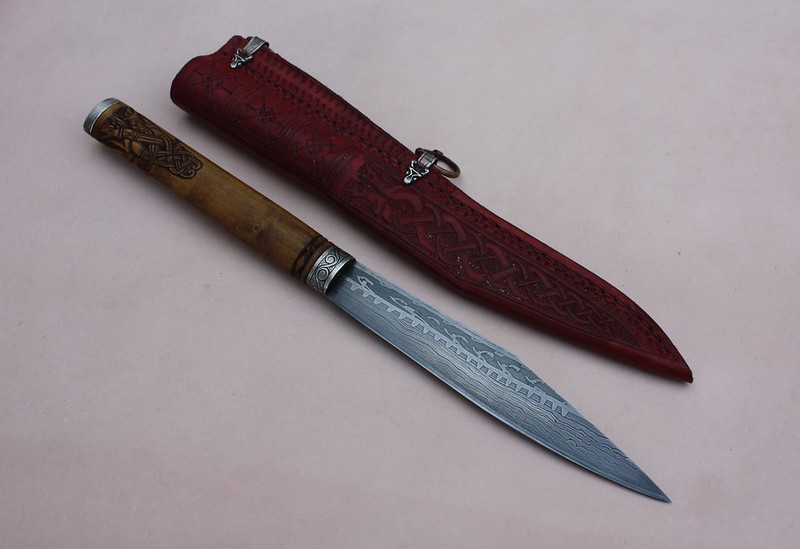 and som more piccies...
and som more piccies... *other side of blade with different patterning...
*other side of blade with different patterning... **nice butt
**nice butt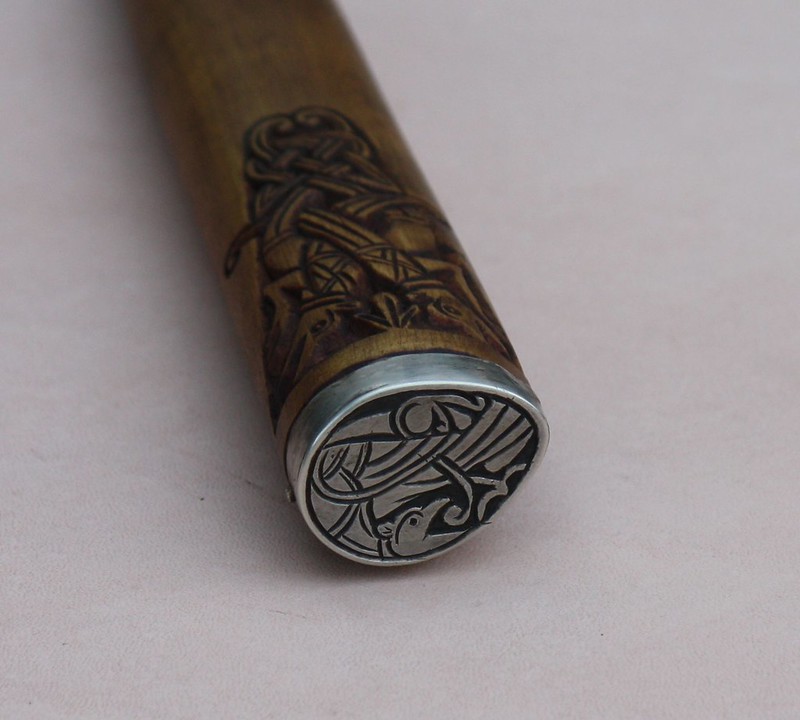
-
Just got this anvil, went for it as its in a flat and usable condition with the idea of using it.
I have no idea how old it may be, and to be honest not sure if I should be using it of keeping it dry and clean?

-
I considered buying one of those hammers for my school .but as I have two nearly up and running project hammers it seemed a little extravagant.
I would not worry about a smaller air hammer struggling with big work which it will, but you can still get it done . It just takes more time .
I am fairly certain that I have forged a lot bigger than that on a 15kg Anyang as I used one for a weekend welding up a patternwelded sword for a demo and have watched one being fed a diet of damascus billets at my forge ins (normally a lot bigger than 25mm)...
Old hammers are nor for everyone and I can certainly understand wanting to be able to get parts . There is a certain something about them though.
-
somthing like that....
-
Over the past month I have been filming the making of a twisted damascus kitchen knife for a TV show that will probably be called "Crafted".The film crew spent 4 days with me and documented the making of a twisted damascus kitchen knife from start to finish.The premise of the show is to follow the making of an object without any presenters or voiceover........to let the process speak for its self.Its not a show and tell as such and at 30 mins it will be challenging watching for a lot of people....I have high hopes for it. BBC4 are able to make programs for a smaller demographic (half a million viewers or less) so not aimed at the x factor crowd.camera crew setting up for an over the shoulder hammering shot.
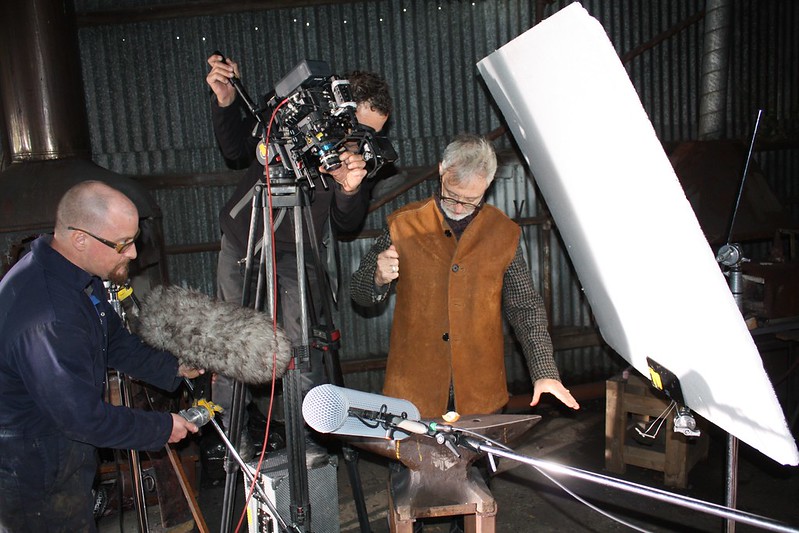 the process and workshop tools will be the real stars, lots of long lingering shots through machenery . These shots are "dirty foreground" shots.... i100 years into its career my kingshorn hammer is discovered....
the process and workshop tools will be the real stars, lots of long lingering shots through machenery . These shots are "dirty foreground" shots.... i100 years into its career my kingshorn hammer is discovered.... They took the sound very seriously with two directional microphones and two mounted on me , one on my foot!!
They took the sound very seriously with two directional microphones and two mounted on me , one on my foot!!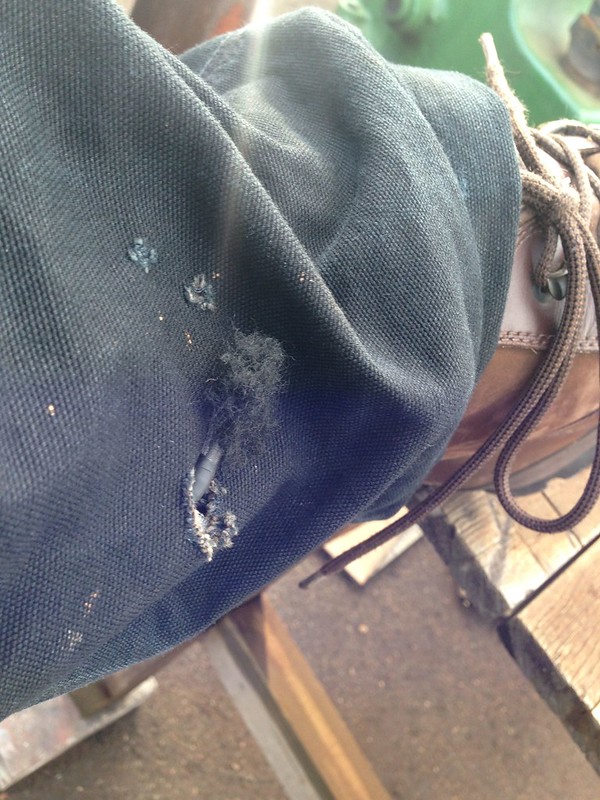 it was a good 4 days and I hope they "Get it" , I think they do. It was satisfying hearing both camera and sound making "whooor" blokey grunts of satisfaction with captured sights and sounds.Here is what I made. 14 layer twisted knife.
it was a good 4 days and I hope they "Get it" , I think they do. It was satisfying hearing both camera and sound making "whooor" blokey grunts of satisfaction with captured sights and sounds.Here is what I made. 14 layer twisted knife. The show should be aired some time next year.
The show should be aired some time next year. -
thanks for the replies.
Steve, the Dao if you are meaning the sword with the bronze fittings ... is in fact a finnish viking age sword . based upon one found in the grave of a finnish princess. I did not get good images of the fittings as the photos were hurried as the class dispersed. The student had the fittings cast before the class from his own waxes. I will hopefully get good pictures when the sword is finally assembled as it was a great piece.
SoCal Dave and Chinobi, I would love to teach this Class on your side of the pond ....but .....I am not sure if I could pull it off in a different workshop environment. I am specifically and well kitted out for getting the work done. I have however taught quite a few Americans, Kiwis , Australians, South Africans, Irish ,French, Norwegian, Dutch, Swede's, Finn's, Danes, Italian, and Spanish...........to name but a few.
If you ever come over this way you would be most welcome.
-
Hope its Ok to post this here , thought the brits would see it.
For your viewing pleasure (I hope) I shall be appearing in a couple of telly programs on thursday eve.....
At 8pm Mick Maxen and myself are smelting on George clarks amazing spaces on channel 4....... and then at 9pm I am on the bbc 4 program Castles - Britain's Fortified History helping the presenter with a bit of sword forging.
all the best Owen -
Belt grinder, power hammer , gas forge in that order..... I could live without the gas forge , Id hate to but I could .
both the belt grinder and power hammer work at over 10 to one against hand work.
and dremmel or its big brother pendant grinder. the dremmel changed a half day job with a file.... into a 1 hour job...
-
I ran another class last week...... very satisfying class with lots of variation in the swords.
One western martial-artist with very specific sword geometry , an art student making a sword for a sculpture, a bronze caster with his own cast sword fittings and a kendo student wanting to make a water quenched wakizashi ( which thankfully worked out lovely and in one piece.....).
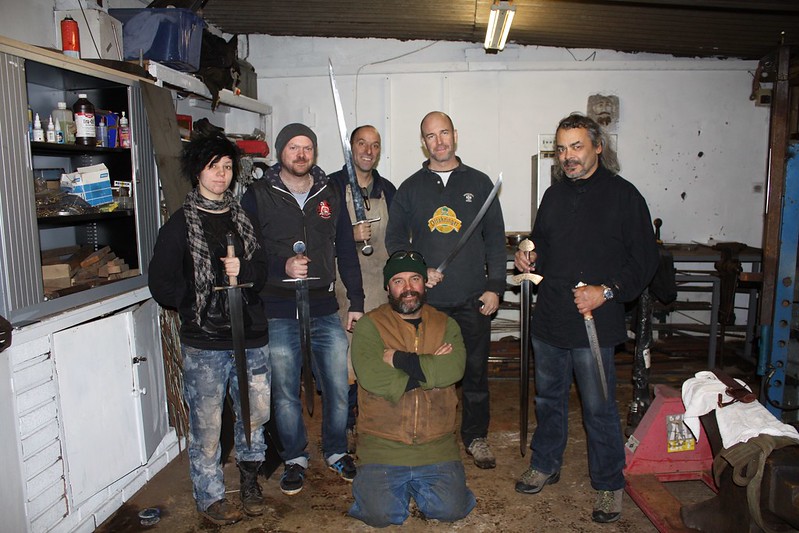
and their swords...
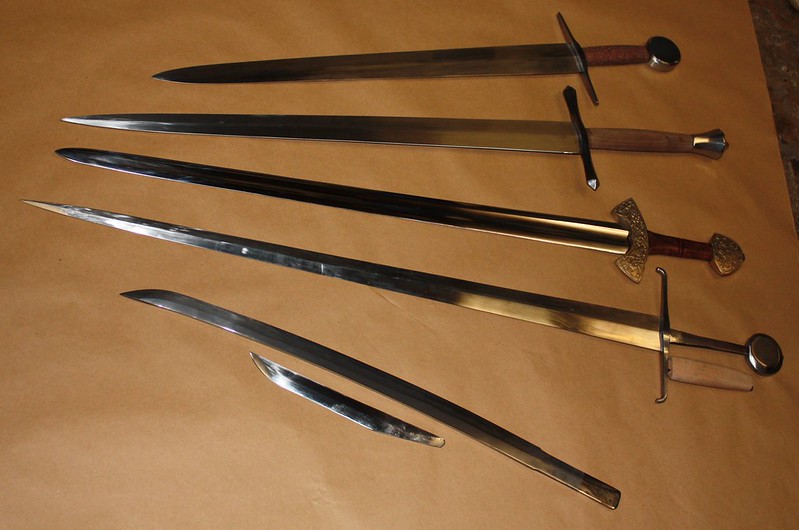
this was the best hamon image i could get at short notice , good sori and nice hamon depth and action ....and quenched in water.....
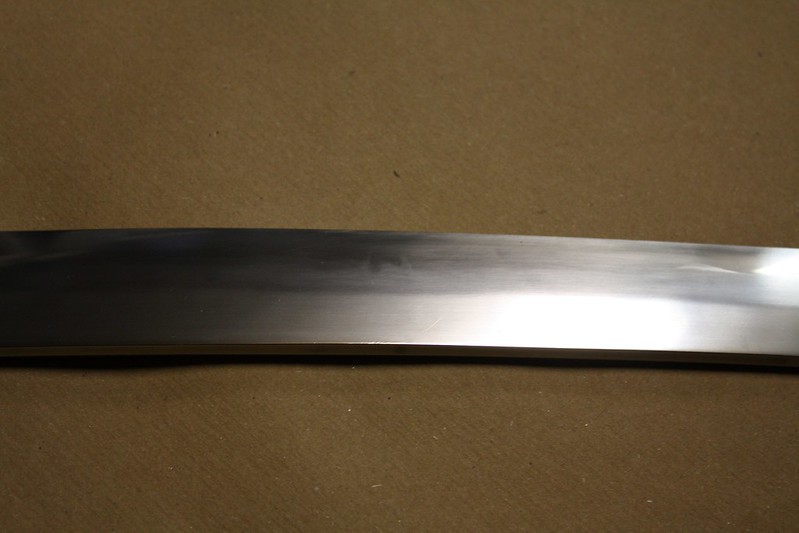
-
I got the grinder from the local engineering shop and have been waiting for the rite job for it. works well. I think it may have been a tube polisher?
-
well its finally done,
total weight is now 872 lb...
Matthew in the piccie did most of the work, between 2 and 3 days work so not worth it from an english perspective but does the anvil justice.....
I think it may well be a mousehole.?
final grind of the bick.

after clean up and polish
 ...
... -
I really like this film.
Great view of people who actually remember a process that a lot of us are trying to create from our own distant cultural past.
Great to see it before the info is lost.
I also love the way everybody is gathering round, mucking in and giving it some.
-
I rarely brush. just to remove slag from the fire. I do sometimes wet forge . and occasionally dip the piece in water quickly and then brush.
steam is often used in industry to blow the scale prior to rolling.
I tend to wire brush with a cup brush on a grinder after the forging is done.
-
just seen this add for the perfect hammer seems to have very similar double slide feature......
-
Foundry man the clapper wrought you gave me is the best wrought I have ever used or seen...soft and loverly.
-
I have it under my 200 weight, and was lucky enough to get a cast off "Ta john". I cant reference it against any of my other hammers exactly as the 200 also has a purpose built separate foundation . but it works very well.
I have used rubber and conveyer belt and the segmented anti vibration rubber and not noticed good results from them. Ie still feel the smaller hammers through the floor.
It is a very interesting material, looks a bit like plasticised mdf . I use the corner off cuts as a dead blow material to put under hand hammer handles when I am wedging them up . it kills rebound instantly.
There must be someone on your side of the pond with an off cut.
-
I am sourcing a motor for this hammer. my experience would normally be to over speck the motor as I have found that hammers run better that way. I am very dubious of p the 3/4hp rating from the ad in this thread .
I have run 60lb goliath with a 1hp motor but its better 3hp motor a and they run much better with 5hp..... no lag in the motor on pick up.
however I am mounting the motor way up high and the less the weight the better.
So 90lb spring hammer running at 300bpm will probably require about double (1.87) the power of a 60lb hammer at 240bpm ( if the relationships for speed increase are linear, which Im not sure they are.).
I recon that a 4 or 5 hp motor should do it . 7.5 would run an air hammer of a similar size so it should be about rite.
I can get a 4kw 1400 rpm motor on ebay old stock unused for £50 so I will give that a go with a small pulley.....weighs around 30kg...not to ridiculous.
-
I bet that will be a real thumper . what RPM is it seta at?


Happy new year.
in Blacksmiths and Metalworkers Association of the South West UK
Posted
Wishing you all a great new year.
Happy smithing in 2015